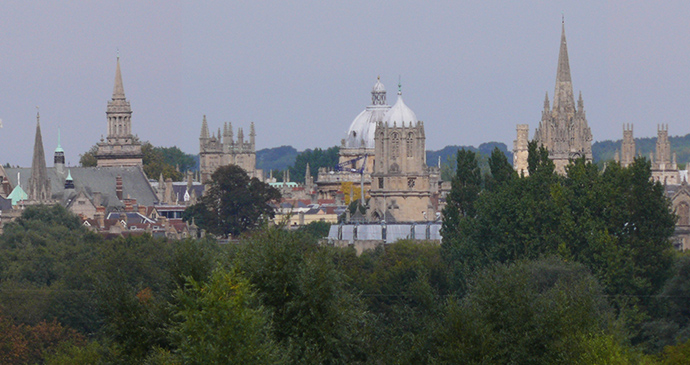Summertown & Cowley
East of the city
Southwest of the city
Port Meadow
Wytham
Sometimes the world of academia and streets filled with ancient institutions can begin to feel slightly claustrophobic and the need to escape bombards the mind.
Summertown & Cowley
Visit the multicultural Cowley Road and head off to the Mini Plant at Cowley.
Summertown is a vibrant suburb to the north of Oxford with its own community feel and collection of shops and restaurants. It still retains the buzz of city life but without the glut of historic buildings. Alternatively, visit the multicultural Cowley Road and head off to the Mini Plant at Cowley where the bodywork of the Mini car is manufactured, a ‘sample’ decorating the factory roof as if perched ready for some kind of Italian Job stunt.
East of the city
With views over the city from the hilltop, bracken-covered slopes sit side by side with ancient woods flowery meadows, marshes and ponds.
To the east of the city is Shotover Country Park, where 289 acres of hillside can be explored. With views over the city from the hilltop, bracken-covered slopes sit side by side with ancient woods – it was once part of the royal forest of Shotover – flowery meadows, marshes and ponds. Celandines, bluebells and ox-eye daisies swathe slopes frequented by butterflies, song thrushes and muntjac deer. The three waymarked trails all begin from Mary Sadler’s Field, near the free car park at the hilltop entrance, plus an extensive network of other paths.
A 20-station orienteering course is marked out around the park too – look out for the red and white marker posts. Shotover Wildlife provides details of all the entrances to the park and public transport from the city centre. The group offers numerous volunteer conservation days, courses and events throughout the year, led by leading ecologists.
Southwest of the city
Matthew Arnold’s poem attracted many people who built houses there to take advantage of the view he described.
The other high point, to the southwest of Oxford, is Boars Hill, where Matthew Arnold wrote about Oxford’s dreaming spires. His poem attracted many people who built houses there to take advantage of the view he described, and the view disappeared. Jarn Mound was built by hand to retrieve the vista across the land on the north side of the hill, which is now owned by the Oxford Preservation Trust, an organisation similar to the National Trust, but specifically for Oxford. The trust also owns other areas of Boars Hill including Abraham Wood, with public access.

Port Meadow
It was this section of the Isis, alongside Port Meadow, that Lewis Carroll and his young companions – Alice Liddell and her sisters – rowed one summer’s day.
Perhaps Oxford’s most celebrated outlying area is the low-lying Port Meadow, adjoining Wolvercote Common. The 300 acres of riverside common land is a popular strolling ground, accessed at its southern end from Jericho close to the city centre and at its northern end from Wolvercote, where the popular Trout Inn tucks up against a spur of the River Isis (Thames). The Thames Path gives distant views of Oxford’s roofline to the south and the remains of Godstow Abbey to the north. The shallow spur of the river by the Airmen’s Bridge just west of Lower Wolvercote makes this part of the water meadow a popular place for bathing, especially as it has a picnic area and a free car park.

It was this section of the Isis, alongside Port Meadow, that Lewis Carroll and his young companions – Alice Liddell and her sisters – rowed one summer’s day. During the trip the story that would become Alice’s Adventures in Wonderland was created. Oxford River Cruises run boat trips along this stretch of the river, including a ‘Mad Hatter’s Tea Party’ on board, from the Perch Inn at the tiny village of Binsey. Lunchtime picnic trips and straightforward sightseeing trips alongside Port Meadow are offered too.
Wytham
Tucked over the little Wytham stream with its handsome manor house and church, the village is worlds apart from city life.
One final hideaway, only a mile west of Port Meadow is the tiny village of Wytham. It was a tradition before the age of the car for residents of Oxford to drive out from the city with a pony and cart for strawberry teas at Wytham. The University of Oxford owns most of the village today – Wytham Great Wood, on the hill behind, is a large ecological research ‘laboratory’ for the study of birds. Tucked over the little Wytham stream with its handsome manor house and church, the village is worlds apart from city life. The little village shop includes a tea garden where the tradition of having a strawberry tea continues. Opposite is the cosy White Hart Inn, with a very pleasant walled garden surrounded by the woods. You can walk to the village from the city using the Thames Path or by crossing Port Meadow and walking the last few yards along the quiet road from the Trout Inn.